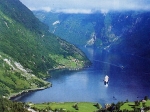 A fjord is a glacially overdeepened valley , usually narrow and steep-sided, extending below sea level and filled with salt water.
A fjord is a glacially overdeepened valley , usually narrow and steep-sided, extending below sea level and filled with salt water.
Fjords are found in locations where current or past glaciation extended below current sea level. A fjord is formed when a glacier retreats, after carving its typical U-shaped valley, and the sea fills the resulting valley floor. This forms a narrow, steep sided inlet (sometimes as deep as 1300m) connected to the sea. The terminal moraine pushed down the valley by the glacier is left underwater at the fjord's entrance, causing the water at the neck of the fjord to be shallower than the main body of the fjord behind it.
This shallow threshold and the protection afforded by the valley's sides generally means that fjords are excellent natural harbours. Consequently fjords often provide a home-port to fishing fleets, and in industrialised locations have come to be used for fish farming and shipbuilding .
As late as 2000, some of the world's largest coral reefs were discovered along the bottoms of the Norwegian fjords. These reefs were found in fjords all the way from the north of Norway to the south. The marine life on the reefs is believed to be one of the most important reasons why the Norwegian coastline is such a generous fishing ground. Since this discovery is fairly new, little research has yet been done. So far, only the deep sea diver who discovered the first reef at 60 meters has visited it, and even he has only been down three times. The reefs are host to thousands of lifeforms such as plankton, coral, anemonies, fish, several species of sharks, and many more one would expect to find on a reef. However most are specially adapted to life under the greater pressure of the water column above it, and the total darkness of the deep sea.
New Zealand's fiords are also host to deep sea corals, but a surface layer of dark fresh water allows these corals to grow in much shallower water than usual. An underwater observatory in Milford Sound allows tourists to view them without diving.




